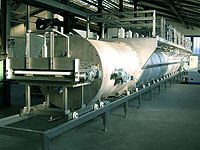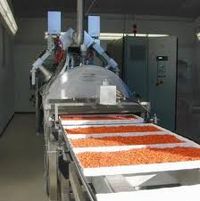Difference between revisions of "Microwave Dryers"
Jump to navigation
Jump to search
| Line 10: | Line 10: | ||
[[File:Microwave_Dryers_2.jpg|thumb|right|200px|Microwave Dryers 2]] | [[File:Microwave_Dryers_2.jpg|thumb|right|200px|Microwave Dryers 2]] | ||
For many years, inventors have tried to develop versions of '''Microwave Dryers''' for thermoplastics. The '''Microwave Dryers''' can be practically used for drying plastics in a production setting. | For many years, inventors have tried to develop versions of '''Microwave Dryers''' for thermoplastics. The '''Microwave Dryers''' can be practically used for drying plastics in a production setting. | ||
==='''Advantages'''=== | ==='''Advantages'''=== | ||
* Continuous or Batch operation | * Continuous or Batch operation | ||
| Line 16: | Line 18: | ||
* The energetic conversion of the microwaves into heat takes place directly in the product. | * The energetic conversion of the microwaves into heat takes place directly in the product. | ||
* The resulting steam pressure ensures rapid and direct outlet of the water from the product. | * The resulting steam pressure ensures rapid and direct outlet of the water from the product. | ||
==='''Applications'''=== | ==='''Applications'''=== | ||
* Food, Pharmaceutical, Cosmetic and Chemical industry for the drying of heat sensitive products or products sensitive to oxidation. | * Food, Pharmaceutical, Cosmetic and Chemical industry for the drying of heat sensitive products or products sensitive to oxidation. | ||
* Drying of thick product with low thermal conductivity. | * Drying of thick product with low thermal conductivity. | ||
* Low temperature drying of fruits, vegetables, meats. | * Low temperature drying of fruits, vegetables, meats. | ||
=='''Video'''== | =='''Video'''== | ||
<youtube>nVHoHsEAr4Y</youtube> | <youtube>nVHoHsEAr4Y</youtube> | ||
Revision as of 13:52, 30 July 2012
For many years, inventors have tried to develop versions of Microwave Dryers for thermoplastics. The Microwave Dryers can be practically used for drying plastics in a production setting.
Advantages
- Continuous or Batch operation
- Volumetric drying or heating
- Immediately regulation capability
- The energetic conversion of the microwaves into heat takes place directly in the product.
- The resulting steam pressure ensures rapid and direct outlet of the water from the product.
Applications
- Food, Pharmaceutical, Cosmetic and Chemical industry for the drying of heat sensitive products or products sensitive to oxidation.
- Drying of thick product with low thermal conductivity.
- Low temperature drying of fruits, vegetables, meats.
Video

